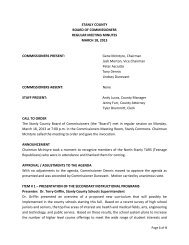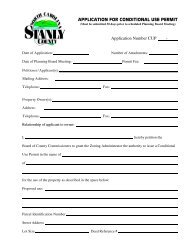Land Use Plan – 2002 - Stanly County, North Carolina
Land Use Plan – 2002 - Stanly County, North Carolina
Land Use Plan – 2002 - Stanly County, North Carolina
You also want an ePaper? Increase the reach of your titles
YUMPU automatically turns print PDFs into web optimized ePapers that Google loves.
STANLY COUNTY<br />
SECTION 5: ISSUES AND OPPORTUNITIES<br />
Introduction<br />
In order to identify and define development opportunities, as well as goals and objectives for the<br />
<strong>Land</strong> <strong>Use</strong> <strong>Plan</strong>, it is first necessary to examine all the issues impacting <strong>Stanly</strong> <strong>County</strong> and its<br />
citizens. The identified planning issues fall into three categories—development issues,<br />
infrastructure issues, and community image issues—and form the basis of the development<br />
opportunities for the county. Development issues and opportunities in turn serve as the<br />
justification for the plan’s goals and objectives.<br />
Citizen Participation Process<br />
After the Phase I report has been reviewed by the <strong>Land</strong> <strong>Use</strong> <strong>Plan</strong> Steering Committee at its July<br />
2001 meeting, a series of four public input meeting are planned to take place in mid-August<br />
2001. The meetings, which will take place throughout the county, will allow residents to review<br />
the findings of the existing conditions analysis and preliminary issues identified here. At the<br />
conclusion of the public meetings, the issues identified in this section of the report will be<br />
updated.<br />
Issue Identification<br />
Critical issues concerning development in <strong>Stanly</strong> <strong>County</strong> were identified by using the elements<br />
identified during analysis of existing conditions and from the March 2001 <strong>Land</strong> <strong>Use</strong> <strong>Plan</strong><br />
Steering Committee meeting. This information was summarized into the following three<br />
categories: development issues, infrastructure issues covering transportation, utility, and<br />
community facilities, and community image issues. Figure 5-1 provides a summary of issues<br />
and opportunities facing the future of the county.<br />
Development Issues<br />
<strong>Stanly</strong> <strong>County</strong> lies at the edge of the growing Charlotte metropolitan region, a region that already<br />
encompasses much of Cabarrus and Union Counties. As indicated in Section 2, some census<br />
tracts in <strong>Stanly</strong> <strong>County</strong> have experienced population growth rates in excess of 20 percent.<br />
Specific development issues to be addressed in the <strong>Land</strong> <strong>Use</strong> <strong>Plan</strong> include the following:<br />
Growth from the Charlotte metropolitan region is already impacting parts of the county,<br />
particularly western <strong>Stanly</strong> <strong>County</strong> near Locust, Red Cross, Stanfield, and Oakboro. New<br />
growth needs to be managed so that it does not overwhelm the ability of the county and its<br />
communities to provide needed services.<br />
<strong>Stanly</strong> <strong>County</strong> is just as likely to suffer from the effects of rural sprawl, as it is urban sprawl<br />
from its towns to its rural areas. While parts of western <strong>Stanly</strong> <strong>County</strong> are definitely at the<br />
frontier of the Charlotte metropolitan region, parts of rural <strong>Stanly</strong> <strong>County</strong> are experiencing<br />
from scattered, unsystematic growth away from its historical population centers.<br />
Agriculture is a legitimate land use and it should be planned for and supported by adjacent<br />
land uses. Farmland is a valuable natural resource in <strong>Stanly</strong> <strong>County</strong>, and measures are<br />
needed to protect and preserve prime farmland from development.<br />
The county needs to work to identify, prioritize, and protect its most valuable land assets.<br />
The “rolling Kansas” of west-central <strong>Stanly</strong> <strong>County</strong>, the Pee Dee River Drive corridor, and<br />
land along Tillery Reservoir and Narrows Reservoir areas have all been identified as<br />
valuable countywide assets worthy of preservation. Intensive development—while it should<br />
be encouraged in certain areas of the county—need to be discouraged in places.<br />
<strong>Land</strong> <strong>Use</strong> <strong>Plan</strong> 5-1 6/02






